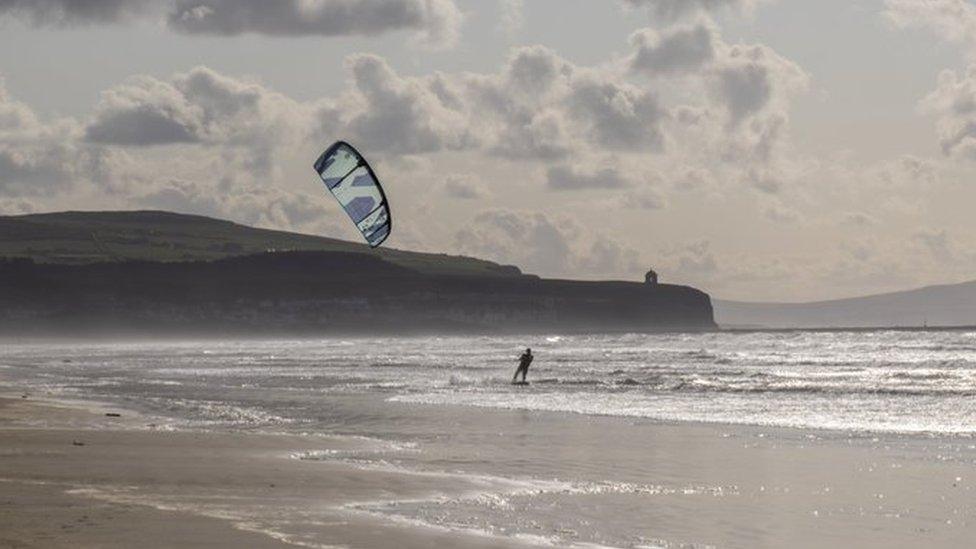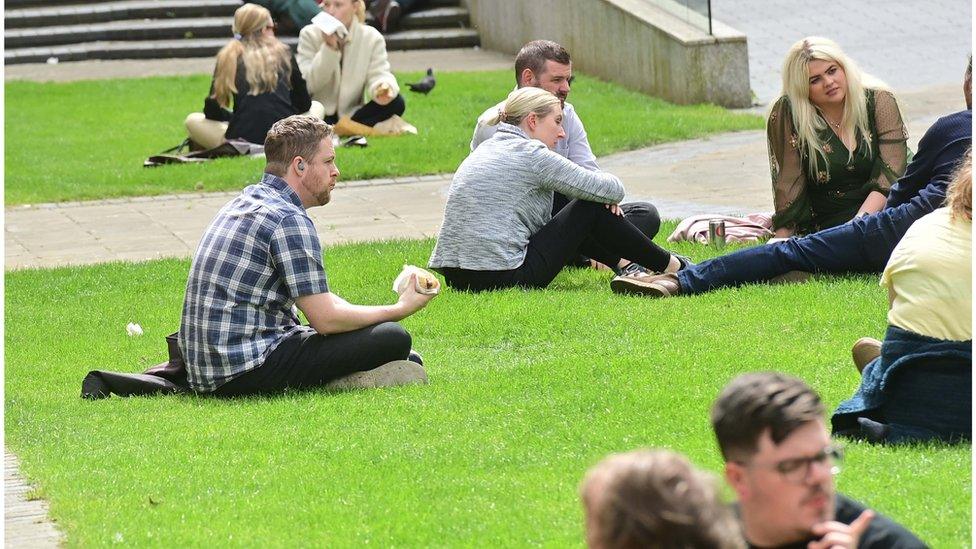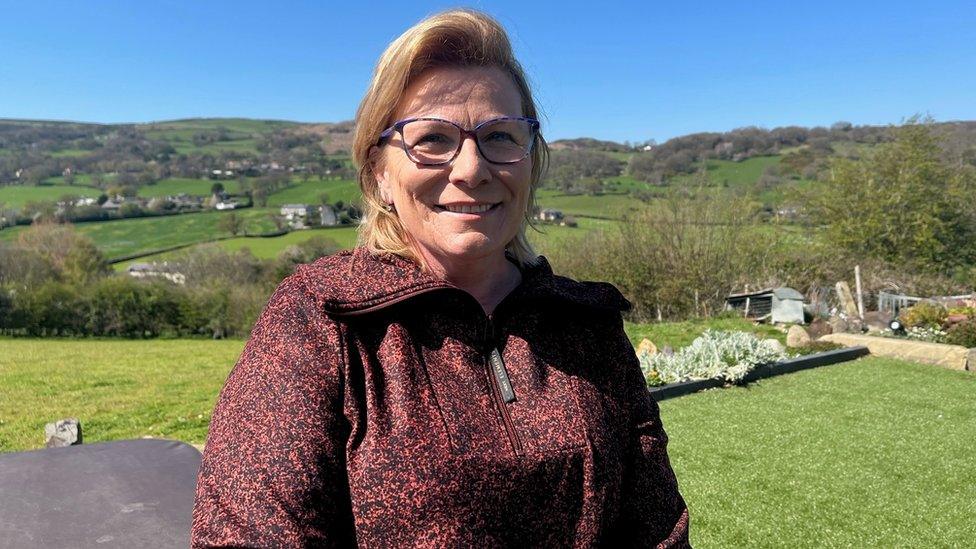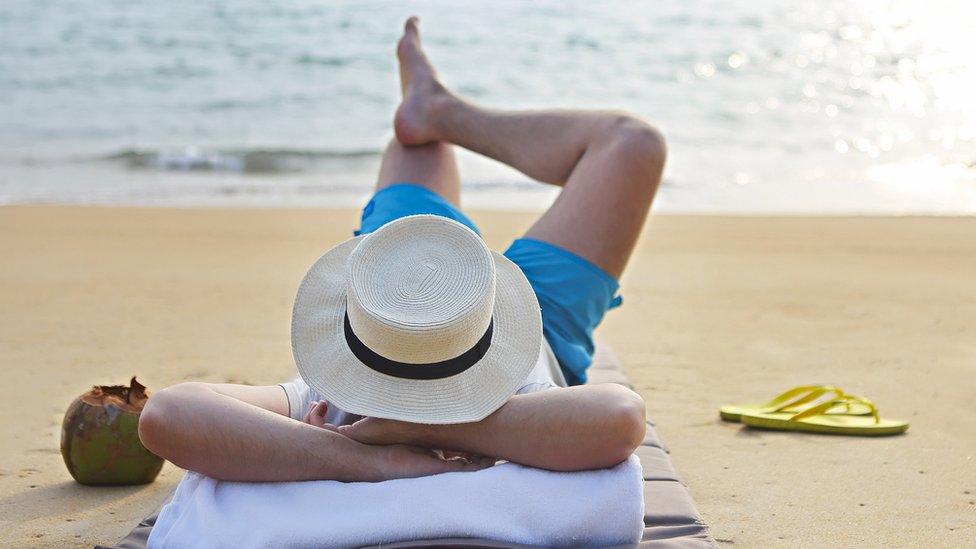Sunburn: All you need to know about UV rays on the bank holiday weekend
- Published

Temperatures are set to rise this bank holiday weekend
It's yet another bank holiday weekend and the weather looks settled - quite warm with sunshine at times. Perfect conditions for enjoying the great outdoors.
But whether its 12C or 20C, there is still a high risk of sunburn at this time of year.
The issue is not how hot it is, but how high the UV levels are.
The UV index is likely to be between three and five this weekend - standard for this time of year.
According to Cancer Focus NI, the UV Index shows how much ultraviolet radiation is reaching us from the sun, external and how careful we need to be.
Ultraviolet (UV) levels vary with the seasons and time of day, but when the UV index is three or above, we need to protect our skin and eyes.
So it is important to know what the UV index is going to be throughout the day where you are.
Denise McCallion, health improvement manager at the Public Health Agency (PHA), said although sunlight was important for our overall health and wellbeing, too much UV radiation from the sun can cause damage to the skin and lead to skin cancer.
"In Northern Ireland, the UV levels are often three or more, even on cool or cloudy days, and the rays from the sun can be strong enough to damage our skin and eyes," she explained.

Botanic Gardens is a popular spot to enjoy some sun
According to the charity Skcin, up to 90% of skin cancers are preventable by adopting simple sun-safe strategies. , external
Skin cancer is also the only cancer we can physically see developing in its early stages and if detected, diagnosed and treated early enough, almost all cases are curable.
Sunburn occurs when your skin is overexposed to UV radiation from the sun's rays, and this can also result from sunbeds.
The NHS warns that many sunbeds radiate greater doses of UV rays than the midday tropical sun and can cause your skin to age prematurely.

Even partly cloudy conditions will not block out the harmful rays of the sun
Research from NI Health Survey (2021-21) indicated that 31% of people in Northern Ireland don't use sunscreen., external
Skin cancer is the most common cancer in Northern Ireland and melanoma cancer is on the rise with an average of 11 new cases per day.
Even when it is cloudy, UV levels can be high and potentially harmful.
A cool breeze can be misleading, especially in coastal areas where there is additional reflection from the sea, according to Doreen Regan of Cancer Focus NI.
'SPF is water resistant, not waterproof'
The skin cancer strategy coordinator explained that when the UV index is three or higher, you should stay in the shade or wear sunscreen with a high sun protection factor (SPF).
"Don't rub it in too much either, leave a thin layer of sunscreen to be absorbed so it literally acts as a barrier to the UV rays," she said.

Cancer Focus NI stress the importance of wearing sunscreen with a high SPF
"Also, remember to reapply after being in the pool - the SPF may be water resistant, but it is not waterproof. If we don't feel hot, we can fool ourselves into thinking we're okay."
Higher temperatures do not increase the risk of sunburn, but if it is warmer, we are more likely to be outdoors and less covered up.
It said that the sunscreen label should state it provides good UVA protection and that those that contain reflective substances, such as titanium dioxide, provide the most effective protection.

There is also UV reflection from white sand and the ocean
The main factors affecting the strength of UV radiation reaching the earth's surface are:
The elevation angle or height of the sun in the sky - it is higher during spring and summer and strong enough to cause damage between the months of March and October.
The amount of cloud, dust and pollution in the atmosphere and the amount of ozone gas in the stratosphere - ozone absorbs much of the UV radiation before it reaches the ground
In the UK and Ireland, the index rarely goes above eight, which is the lower end of very high. At these times, the World Health Organisation (WHO) advice is to spend time in the shade between 11:00 and 15:00. It also advises wearing a shirt, sunscreen and hat.

Young people enjoying the sun in Belfast's Botanic Gardens
In countries closer to the equator, the sun will be higher in the sky and overhead for a lot longer, therefore the UV index will be higher again and the sun appears stronger.
The UV index measures two types of ultraviolet radiation - UV A and UV B
UV B causes sunburn and UV A penetrates the skin deeper and will still come through on a cloudy day, so sunscreen needs to protect against both.
People should also take into account that the light can reflect off snow, for those who ski, as well as white sand and the ocean.
Ultimately, all skin needs protection:
"Anyone can develop skin cancer, whatever their skin type," said Ms Regan from Cancer Focus NI.
"If you work outside or spend a lot of time outdoors, you might think your skin is tougher and doesn't need protection, but UV damage can still occur, so take care."
Related topics
- Published27 April 2023

- Published15 July 2022
